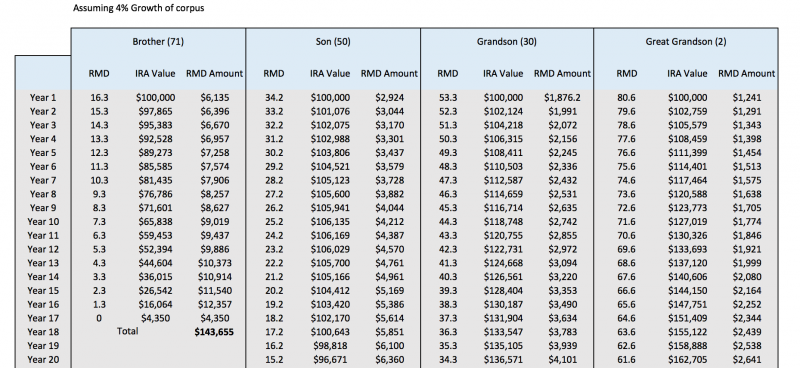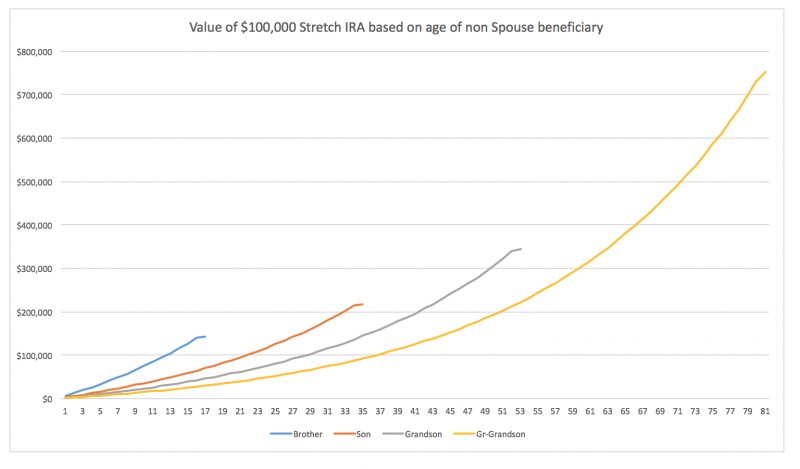A Stretch IRA is the term given to finding younger generations to be beneficiaries of IRA accounts in order to prolong the lifetime of the IRA vehicle post mortem. In order to understand the application of a stretch IRA it is important to be aware of the required minimum distribution (RMD) rules. Traditional IRA accounts have a forced withdrawal process known as Required Minimum Distributions which start on April 1st following the year that the owner turned 70 1/2.
The amount that the owner is forced to withdraw is calculated by looking up the IRS life expectancy table table and dividing the amount of the IRA by the number given. Consider this the “RMD divisor”. It is important to note that the IRS requires you to use one table for regular RMDs (for the original owner of the IRA) and another for beneficiaries.
- Table for original owner: IRA worksheet for RMD distributions
- Table for beneficiaries: Single life expectancy table (Pub 590-B Appendix B Table I)
A stretch IRA occurs when the beneficiary of the IRA in question is non spousal, the impact on the amount of the divisor means that more money can accrue within the IRA account over time, offering tax advantages. The first divisor is found by looking up the single life expectancy table in year 1, and thereafter deducting one year from that number. The value of a stretch IRA can be seen when you consider that year 1 of a beneficiary IRA could start as young as age zero for a child beneficiary.
To see this in action, you can consider 4 generations, a twin brother, aged 71, the owners son, aged 50, the owners grandson aged 30 and the owners great grandson, aged 2.
Using the single life expectancy table, we get the following year 1 divisors, which would force RMDs from an inherited IRA valued at $100,000 as follows:
- Twin Brother (age 71) starting RMD Divisor 16.3
- Son (age 50) starting RMD divisor 34.2
- Grandson (age 30) starting RMD divisor 53.3
- Great Grandson (age 2) starting RMD divisor 80.6
- The divisor works as follows:
Value of IRA/divisor number = RMD
The excerpt of a table below shows the impact of the ages over the first 20 years on the balance of the initial $100K IRA:

It seems quite amazing that the pressure to RMD when aged 71 forces the account to liquidate by year 17, with a total of $143,655 distributed from the initial $100,000 when compared to the RMD application for the grandson, which creates 81 years of payments, and a total of $752,247 distributed from the initial $100,000. This can be better viewed by the chart below:

Some caveats
The chart implies a huge value from designating a younger beneficiary, however, it is important to consider not just how much money is being distributed by the IRA, but also where said money is going. In a fair comparison betweeen the Brother (age 71) and Great Grandson (age 2) the Brother gets larger amounts of money distributed sooner, which can go on to be invested in another capacity.
This highlights the real advantage of the Stretch IRA approach: taxation. The larger RMD amounts may well push a person into higher income tax brackets, meaning that more of the IRA was taxed at higher rates, whereas a younger beneficiary might well be in a lower tax bracket. In the extremes, Brother vs Great Grandson clearly the tax brackets will more often favor the infant, though this can trigger Kiddie Tax.
Kiddie tax relates to unearned income for children that exceeds $2100 in 2016. The first $1,050 is tax free, the next $1,050 is taxed at the Child’s rate (10% if there is no other income), and amounts thereafter are taxed at the Parent’s’ rate. With the example I used above, it is likely that Kiddie tax will not be an influencing factor, but if the child or grandchild was a little older, or the IRA balance was higher, it could well come into play. Done correctly, the amount taxed from the IRA could be considerably lower than if the Brother (eldest possible beneficiary in the example) was the beneficiary.
Each case is different, so it is important to consider the ages, current income, and RMD requirements for each potential option when planning a stretch IRA. Furthermore, the actual implementation of the strategy can be very tricky, and a minor administrative error can ruin the entire strategy, as such, tread very carefully, and retain a professional to help implement this if it seems like it is something you will use for wealth transfer.
Can there be more than one beneficiary of a Traditional IRA?
Yes, but it has to be done carefully. Multiple benes should properly retitle the inherited IRA and then can take RMDs based on their life table, if they do not split it using retitling it will be treated differently for tax purposes.
Great explanation. Thank you!
A factor to consider is that an inherited IRA belongs to its new owner, and there are no controls over how the money is invested or if it is left in the IRA. I am working on our IRA plan now and over the weekend I saw articles which mention that a big percentage of inherited IRAs are cashed in soon after receipt, which destorys most of the reason for using that mechanism.
It is possible to leave an IRA in a trust, but there are only a few small firms handling those at present, and I am wary of handing an IRA designed to last decades over to a small, relatively untested outfit.
“handing an IRA designed to last decades over to a small, relatively untested outfit.” That’s a funny way to describe a 2 year old 🙂
You raise a great point though, not only will they use it properly, but do you even want that money to skip generations, when doing so can create unusual implications in terms of the various family members who can be involved in the total inheritance.
Matt-
The ‘outfit’ I was referring to was the trustee of the bequeathed IRA. There are only 3 or 4 companies that do that, and I wonder how well they would pick investments, and whether they mkght lean toward in-house products.
Your other point (and one I share) is leaving big money to someone whose charecter and values are completely unknown, which they all are at age 2. And for many at 12. I have often said that the best case for keeping the estate tax is Paris Hilton.
Hey Sam, sorry been traveling a lot this week… Would be keen to see what outfits you have seen for this. It’s also worth noting that other systems for this would exist.